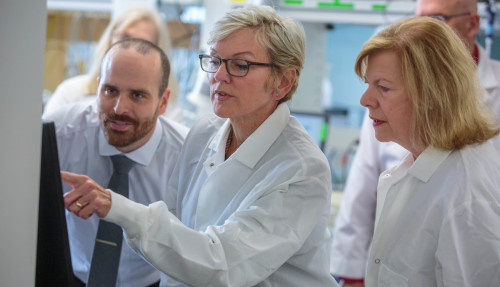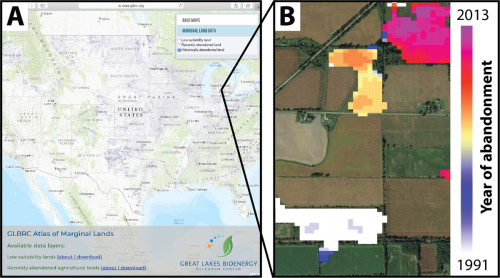A map displaying the proportion of deserted farmland inside a 36-square-kilometer space. A lot of the greater than 30 million acres of cultivated land deserted between 1986 and 2018 is concentrated within the Nice Plains and the Mississippi River valley.
Farmland is commonly a battleground within the struggle towards local weather change.
Photo voltaic panels and vitality crops are pitted towards meals manufacturing, whereas well-intended coverage selections can create incentives for farmers to until up new lands, releasing much more heat-trapping fuel into the environment.
That’s why methods for sustainable plant-based fuels deal with marginal lands — fields which might be too laborious to domesticate or don’t produce adequate yields to be thought of worthwhile.
A brand new instrument developed by scientists on the College of Wisconsin–Madison may assist relieve that pressure.

U.S. Vitality Secretary Jennifer Granholm (center) and U.S. Senator Tammy Baldwin (proper) converse with Tyler Lark (left), scientist with the Nice Lakes Bioenergy Analysis Middle about an interactive instrument for mapping deserted farmland that could possibly be used for vitality manufacturing throughout a tour of the Wisconsin Vitality Institute at UW–Madison on June 16, 2023.
Led by Yanhua Xie and Tyler Lark, researchers with the Nice Lakes Bioenergy Analysis Middle, the crew used machine studying to map practically 30 million acres of United States cropland deserted for the reason that Nineteen Eighties, making a instrument that might information selections about how you can stability manufacturing of vitality and meals.
Their findings, printed within the journal Environmental Analysis Letters, embody probably the most detailed mapping of beforehand cultivated land within the U.S. to this point. They supply field-level decision of deserted farmland that could possibly be used to develop crops like switchgrass or sorghum, which might lure carbon within the soil and function feedstocks for biofuels and replacements for petrochemicals.
“If we will perceive the place these lands are and what the traits are, we will actually perceive their true potential for issues like local weather mitigation,” says Lark, a scientist at UW–Madison’s Middle for Sustainability and the World Setting.
Lark, who research land use change and its impacts on land and water assets, says that understanding could possibly be used to direct clear vitality investments the place they’ve the least competitors with different helpful makes use of.
“That’s a key utility of this,” Lark says. “Whether or not it’s for photo voltaic photovoltaic, or agrivoltaics, or cellulosic bioenergy growth, or simply restoration of pure ecosystems: These websites could possibly be nice candidates for lots of these purposes.”

Screenshot of the GLBRC Atlas of Marginal Lands, which permits customers to discover and obtain spatial datasets (A), and a zoomed-in instance of the deserted cropland dataset in a 1.5km2 part of southern Michigan (B). Subject shade in (B) signifies the earliest yr through which land was now not cultivated.
The examine was a collaboration between researchers at UW–Madison and Michigan State College and was funded by the U.S. Division of Vitality. The ensuing information are publicly accessible within the GLBRC’s interactive atlas of U.S. cropland, which additionally maps developments in farmland enlargement and irrigation.
Researchers have historically relied on datasets just like the USDA’s Census of Agriculture, which offers county-level estimates of farmland at five-year intervals and can be utilized to estimate how a lot land has been taken out of manufacturing.
However till now there was no manner of realizing precisely the place that land was or when it was deserted.
“Most of those estimates have all been on the county degree,” Lark says. “That is actually the very best decision evaluation accessible, wanting proper on the panorama — discipline by discipline, acre by acre — of the place these crop lands are.”
Whereas satellite tv for pc imagery has been round for many years, with out latest advances in cloud computing, Lark says it was not possible to categorise the practically 2 billion acres of land within the coterminous U.S.

Tyler Lark
To assemble the crew’s analyses, Xie, now a professor on the College of Oklahoma, used current land cowl information to coach a pc to learn these photographs and acknowledge patterns of cultivation. The researchers then had that algorithm analyze satellite tv for pc information from 1986 by 2018 and categorize every pixel to find out whether or not it was cultivated.
The outcomes precisely predict the exact location of deserted croplands 9 instances out of 10 and may even pinpoint the yr they have been deserted with about 65% accuracy.
The crew discovered that greater than 30 million acres of cropland have been deserted over these 32 years. Most deserted land was concentrated within the Nice Plains and alongside the Mississippi River between southern Illinois and the Gulf of Mexico.
These 30 million acres don’t embody urbanized land, which Lark says is unlikely to ever return to cultivation.
Of that deserted cropland, greater than half modified to pasture or grassland and a couple of third was both shrubland, forest, wetland, or naked.
Lark was stunned to find that lower than a fifth of deserted land was enrolled in a proper conservation program, similar to USDA’s Conservation Reserve Program, which pays farmers to take environmentally delicate lands out of manufacturing. Meaning extra land than beforehand thought may probably be used to develop bioenergy crops.
“A number of the assumptions have been that this former cropland had a variety of overlap with formal conservation packages,” Lark says. “However we noticed that they’re nearly solely distinct swimming pools.”
Researchers can now use the ensuing information to mannequin how a lot biomass could possibly be grown on these lands in addition to their potential to lure carbon dioxide from the environment within the soil.
The examine doesn’t clarify why the lands have been deserted.
“The following step is to determine the drivers,” Lark says.
To try this, Lark says the crew might pull in different data like socioeconomic information and tax data to get a greater sense of what’s taking place on the parcel degree — as an example, whether or not a farmer took one discipline out of manufacturing or offered the complete farm — and use that to determine potential makes use of for the land.
“In the event that they’re farming a bunch of hay, that’s in all probability extra simply adaptable to cellulosic biofuel feedstock, as a result of they may have already got the tools … and you might harvest one thing like switchgrass then too,” Lark says. “If it’s someplace the place there’s no agricultural manufacturing in any respect anymore, it is likely to be tougher to try this, however perhaps extra suited to a photo voltaic installment.”






























































